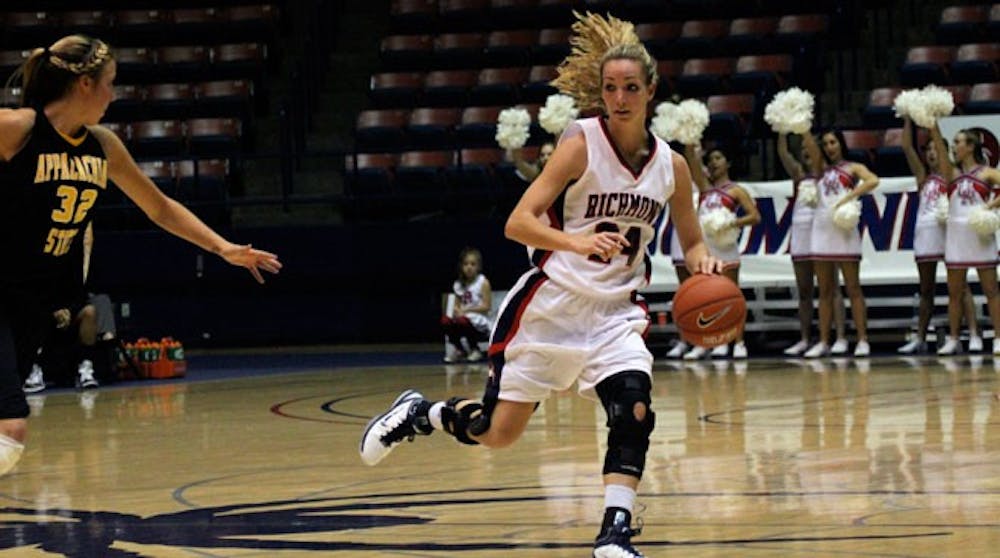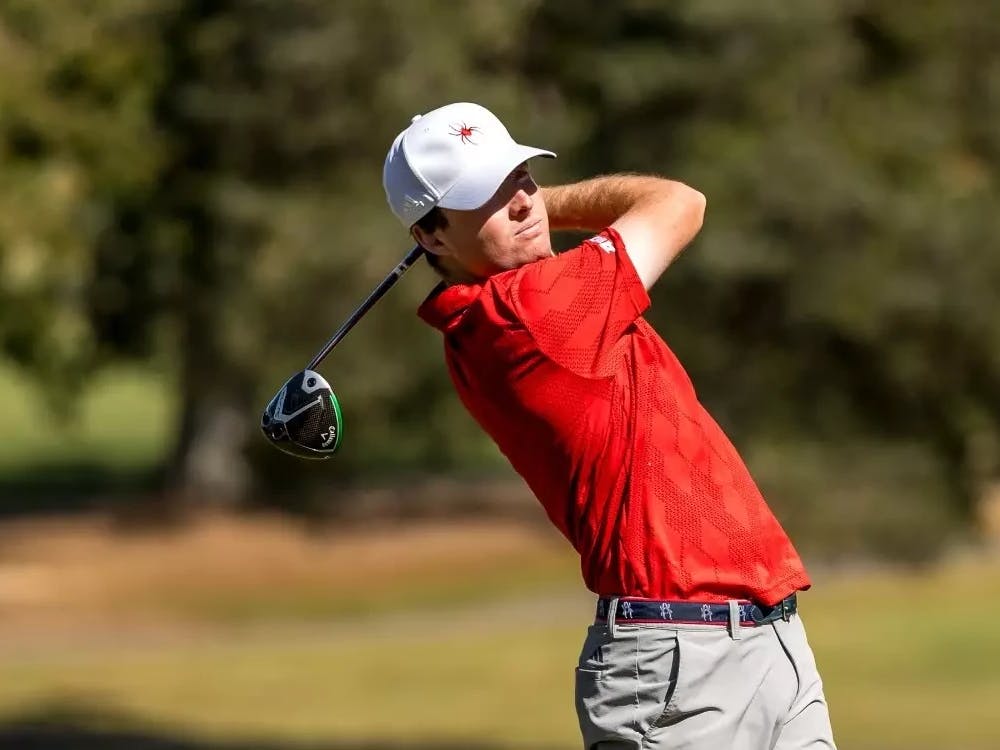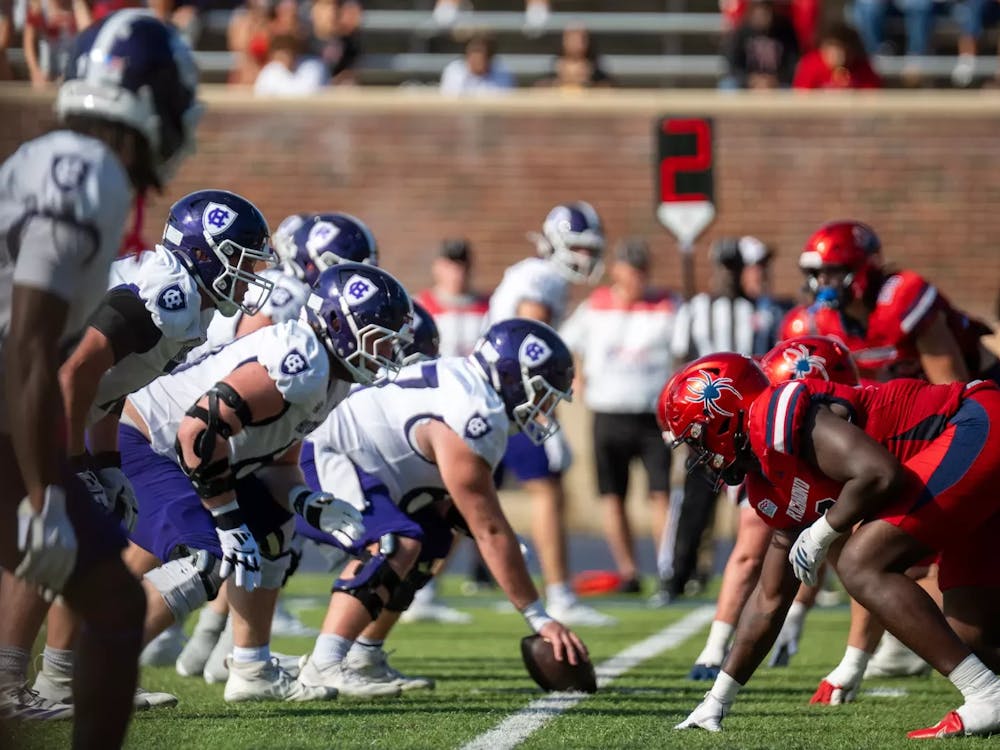All Samantha Bilney has to do is look down to her knees to see what one misstep or awkward landing can do. On her right knee is a scar that extends from the kneecap down to her shin, surrounded by many other little scars, while the countless scars on her left knee are covered up by a knee brace that she wears while playing basketball.
"I stopped counting when it got to 20," said Samantha, a redshirt sophomore forward for the women's basketball team.
Samantha has torn her anterior cruciate ligament three times in her right knee and one time in her left knee. Most recently she tore her right ACL in Oct. 2009 and was forced to sit out last basketball season.
A few years back, it was nearly unthinkable for an athlete to be able to play basketball or any other sport after suffering a torn knee ligament. Although advancements have made it less likely that a torn ACL is a career-ending injury, it's still not an exact science. Former Miami Dolphins quarterback Daunte Culpepper tore his ACL in 2005 and never regained his Pro Bowl status.
Regardless of whether it's a season-ending or career-ending injury, even the best athletes have to go through months of painful rehabilitation. For months, these once athletic players struggle with basic tasks, such as sleeping or taking a shower.
But as Samantha and countless other athletes have shown, what once ended many athletic careers is now just another trial in an athlete's life.
It doesn't take a lot to tear an ACL. Each time Samantha has torn her ACL, it's been in a different way. Sometimes it was on the take-off of her jump, other times it's been when she lands. But a majority of cases happen when the knee is put in an awkward position.
"It was a layup, pretty much a stretched-out layup," said redshirt senior Dan Geriot, a center on the men's basketball team, describing how he tore his ACL in August 2008. "I took two big steps and jumped. I put the ball in and came back down, kind of in the wrong direction. Kind of just turned it and popped."
Geriot's injury occurred when he was playing with the Spiders on a summer tour of Spain, a few months before the start of basketball season. Originally, he did not know the extent of his injury. He said that he thought he had pulled his quadriceps, but only later did he find out about the severity of his injury.
"My quad was burning, basically," Geriot said. "As time went on, an hour or two, it was pretty swollen. I knew I was in trouble."
That is in stark contrast to junior Rachael Bilney's - Samantha's twin sister -- story. Rachael tore her ACL in October, two days before the start of basketball practice. As she was going for a layup in a pick-up game, Rachael stepped on another player's foot as she started to jump, which caused her left knee to buckle.
"I heard the pop," Rachael said. "Because I heard the pop and I've seen Sam do it four times now, I kind of knew what it looked like.
"The first thought in my mind was 'no way' and almost disbelief."
This type of injury doesn't just happen while jumping. Junior quarterback Aaron Corp, who declined to comment about his injury, tore his ACL this season when an offensive lineman accidentally rolled into his leg.
Regardless of how the injury happens, the next step is always the same. Athletes start the rehab right away while waiting for the swelling in the knee to go down. Once the swelling is down, about one or two weeks after the injury, the surgery is performed.
Surgeons have three options to fix the ACL: using a portion of the hamstring, using a portion of patellar tendon from the knee or taking a graft from someone else. Surgeons have repaired Samantha's ACL each way. The first two times she received a graft but has since gone to the patellar and hamstring option. The most recent surgery caused additional problems in Samantha's right knee.
"When you use someone else's [tendon], there's a rejection possibility," Samanth said. "Something happened either with the ligament they put in or the screws they used, where it disintegrated holes in my femur and my tibia."
Samantha had to get more surgery to fix those holes in her bones and also repair some torn meniscus from the original injury. She said that doctors used a mixture of nutrients and a putty-substance to repair the holes.
It's after the surgery that the timeline for rehab differs for athletes, depending on the severity of the injury.
The athletes have to learn how to walk again after surgery and struggle with even the slightest bend of the knee. Rachael is in this stage of her rehab and walks around with a full-leg brace on her left leg.
"I'm really in just the beginning stages," Rachael said. "The most important thing to get back after surgery is quad control. If you look at how little my [left] leg is right now, it's gone.
"Your quad muscle atrophies really fast so getting that [muscle] back enables you to walk better and control your leg."
Rachael's left leg is a little more than half the size of her healthy right leg. She estimates that she lost nearly all of her strength in her left leg within four days after surgery because of the time she spent on crutches.
"I can put pants on, and [the left] side's flabby and [the right] side's tight," Rachael said. "It's not half the size, but it's pretty close."
Rachael attends rehabilitation for about an hour and a half in the morning and again while her teammates practice in the afternoon. She goes through a rigorous serious of stretches in order to get the range of motion in her knee back.
Rehabilitation has been known to bring even the toughest athletes to tears, especially during the early stages when the knee is tough to bend. But Rachel said that she has not felt that much pain.
"I was really nervous for the pain but so far it's been okay," she said. "I guess you kind of have to get used to having a warped sense of pain. If I was still healthy right now and I rolled my ankle, I'd be a bigger baby about my ankle than this because this has been weeks now of this feeling crappy so I've gotten used to this feeling."
Geriot can relate to that pain. Before tearing his ACL, the only issue he ever had was spraining his medial collateral ligament in the spring of 2008 that kept him out one week. As soon as he tore his ACL, he had limited mobility and it took a while for him to get it back.
"You just don't see great strides early," Geriot said. "Two-degrees of bending your knee becomes like a great thing which is not that much."
That process is especially hard for athletes, because of what they used to be able to do, said Geriot.
"You never realize the stuff you can do can go away with the injury," he said. "It kind of went away from me for a while, even last season. That's hard, it's a lot mental."
The mental aspect is one of the hardest parts of the rehabilitation process. When athletes build up enough strength in their knee, they are cleared by doctors to start to run and jog.
But although the doctors have declared them healthy, Samantha said it still took a while for athletes to get their confidence back.
"I think, in the beginning, when I first started going into drills not fully cleared, there's definitely [thoughts] like, 'Well, I don't need to contest [Richmond center] Crystal Goring for that offensive rebound.'
"I think a lot of [getting over any hesitation] will be repetition and playing and just getting out there. Eventually I'm hoping it will all just go away and I'll be a normal athlete," Samantha said.
Doctors have questioned whether Samantha will ever be a normal athlete again. She has heard from doctors that most people who tear their ACL four times and need a bone graft in their knee do not make it back to their original playing level.
"It kind of made me angry," she said. "I had already had the bone graft done and then was told that a lot of people don't come back from that. It was my only option, it was the only thing I could do. When you've got big holes in your knees, you can't attach an ACL through there.
"That was the reality of the situation, I didn't have another option and I wanted to play, she said. "I was going to do what I could."
Despite what she has gone through, Samantha has never stopped to wonder why it keeps happening to her.
"That's actually a question that I avoid, that I don't want to ask myself," Samantha said. "It's an unanswerable question, I can't tell you why me nor can anyone else explain anything. Instead of 'Why me?' it's 'I've recovered before and can do it again.'"
Both Samantha and Geriot have missed a full season of basketball while rehabbing their injury and Rachael is sitting out this season while she recovers. Sitting out the full season allows them to redshirt that year and get a fifth year of eligibility.
"There's never an ideal time to get injured, but like my freshman year when I tore it 22 games into the season, those are games you lose," Samantha said. "Having done it in October [2009] and facing a whole year of recovery, it's a lot better to try to get that redshirt year than to lose the middle [of a season]."
Four ACL tears have left their mark on Samantha. She said that it has taken away some of her jumping ability but she tries not to think about it.
"Back in the day, I could grab rim easily," Samantha said. "Now, maybe off the left [leg] I could. Off the right one, I haven't tried. It's not really necessary to do. I try not to notice it because I'm healed."
Before the first game for the women's team on Nov. 12, Samantha had not played since tearing her ACL in her left knee in a game at Duquesne University of Feb. 1, 2009. Because the Bilney twins have not played together in a game since then, it made Rachael's injury two days before the start of practice that much tougher to take.
"The timing was compounded by the fact that Sam was finally going to be able to play," Rachael said. "So that was what I was most looking forward to because we hadn't played together in like two years."
When the athletes get back to the court for the first time since tearing their ACL, they face a wide variety of emotions. Samantha said that she cried every time she came back.
Geriot said that getting back last year made him realize how hard it was to get back to his All Atlantic-10 Conference status before his injury.
"I was tired against Lehigh [Geriot's first game back last year], that was my first reaction," he said. "Me and coach talked a lot, looking back on it, it's really easy to do well in rehab and it's easy to come back and almost be the leader I was. But it's hard to be good at basketball again."
Although Geriot was able to score his 1,000th career point last year, it wasn't the year that he wanted. In coming back from his ACL injury, Geriot added about 25 pounds to get stronger but that took away from the quickness that made him effective during his first two years. He also played some of the season with a torn labrum in his shoulder that required surgery after the season and his numbers suffered.
Now, Geriot said he is completely healthy.
"I'd probably say last year, looking back on it, I was really close to 100 percent but just some plays I was just hesitant to let myself go," he said. "But now I really do feel great out there and my confidence is through the roof."
Although Samantha is able to play basketball now, there are questions about how healthy her knees will be in the future. She already has arthritis in her knee as the result of tearing her meniscus and doctors have told her that there's a high potential she will need to have her knee replaced. But despite all that, she said there was no thought about stopping.
"I was 19 and already had four ACL tears and I figure I'm still pretty young and I love to play college basketball," she said.
With a smile, Samantha got up after answering the last question and headed out to practice, risking her future for a chance to play the game she loves, knee braces and all.
Contact staff writer Andrew Prezioso at andrew.prezioso@richmond.edu
Enjoy what you're reading?
Signup for our newsletter
Support independent student media
You can make a tax-deductible donation by clicking the button below, which takes you to our secure PayPal account. The page is set up to receive contributions in whatever amount you designate. We look forward to using the money we raise to further our mission of providing honest and accurate information to students, faculty, staff, alumni and others in the general public.
Donate Now



